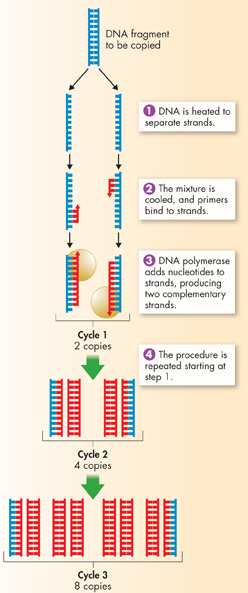Polymerase Chain Reaction Once they find a gene, biologists often need to make many copies of it. A technique known as polymerase chain reaction (PCR) allows them to do exactly that. At one end of the original piece of DNA, a biologist adds a short piece of DNA that complements a portion of the sequence. At the other end, the biologist adds another short piece of complementary DNA. These short pieces are known as primers because they prepare, or prime, a place for DNA polymerase to start working.
As Figure 15–7 suggests, the idea behind the use of PCR primers is surprisingly simple.  The first step in using the polymerase chain reaction method to copy a gene is to heat a piece of DNA, which separates its two strands. Then, as the DNA cools, primers bind to the single strands. Next, DNA polymerase starts copying the region between the primers. These copies can serve as templates to make still more copies. In this way, just a few dozen cycles of replication can produce billions of copies of the DNA between the primers.
The first step in using the polymerase chain reaction method to copy a gene is to heat a piece of DNA, which separates its two strands. Then, as the DNA cools, primers bind to the single strands. Next, DNA polymerase starts copying the region between the primers. These copies can serve as templates to make still more copies. In this way, just a few dozen cycles of replication can produce billions of copies of the DNA between the primers.

FIGURE 15–7 The PCR Method Polymerase chain reaction is used to make multiple copies of a gene. This method is particularly useful when only tiny amounts of DNA are available. Calculate How many copies of the DNA fragment will there be after six PCR cycles? 
Where did Kary Mullis, the American scientist who invented PCR, find a DNA polymerase enzyme that could stand repeated cycles of heating and cooling? Mullis found it in bacteria from the hot springs of Yellowstone National Park in the northwestern United States—a powerful example of the importance of biodiversity to biotechnology!
 In Your Notebook List the steps in the PCR method.
In Your Notebook List the steps in the PCR method.
Changing DNA
 How is recombinant DNA used?
How is recombinant DNA used?
Just as they were beginning to learn how to read and analyze DNA sequences, scientists began wondering if it might be possible to change the DNA of a living cell. As many of them realized, this feat had already been accomplished decades earlier. Do you remember Griffith's experiments on bacterial transformation? During transformation, a cell takes in DNA from outside the cell, and that added DNA becomes a component of the cell's own genome. Today biologists understand that Griffith's extract of heat-killed bacteria contained DNA fragments. When he mixed those fragments with live bacteria, a few of them took up the DNA molecules, transforming them and changing their characteristics. Griffith, of course, could only do this with DNA extracted from other bacteria.
Table of Contents
- Formulas and Equations
- Applying Formulas and Equations
- Mean, Median, and Mode
- Estimation
- Using Measurements in Calculations
- Effects of Measurement Errors
- Accuracy
- Precision
- Comparing Accuracy and Precision
- Significant Figures
- Calculating With Significant Figures
- Scientific Notation
- Calculating With Scientific Notation
- Dimensional Analysis
- Applying Dimensional Analysis




